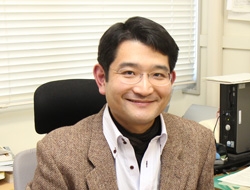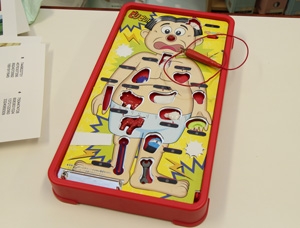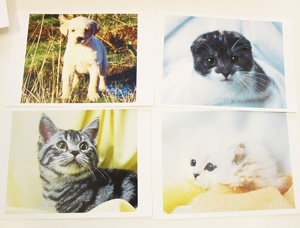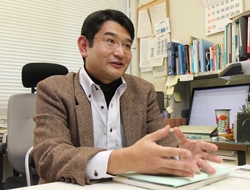We've discovered that viewing cute images improves concentration! Japan is the launchpad for demonstrating the new possibilities offered by “kawaii”.

We talked to Associate Professor Hiroshi Nittono, Behavioral Sciences Section, Division of Human Sciences, Graduate School of Integrated Arts and Sciences.
(Interview: December 4, 2012 by PR Group)
Introduction
The outcomes of a study conducted by a research group led by Associate Professor Hiroshi Nittono of the Graduate School of Integrated Arts and Sciences, concerning "kawaii" (a Japanese word meaning "cute"), were published in the September 26, 2012 issue of the online scientific journal PLOS ONE.
Click here for the published article (link to the PLOS ONE website)
The outcomes showed that people's performance in tasks requiring focused attention improves after viewing cute photographs of baby animals. This demonstrates that viewing cute things not only makes people feel good, but also brings about a change in their behavior.
"Kawaii" is something that attracts attention not only within Japan, but also overseas. We interviewed Associate Professor Nittono, who demonstrated the new possibilities of this theme, which appears to be well-known, but regarding which research had not progressed very far.
What happens when people feel that something is cute?
Associate Professor Nittono's specialism is cognitive psychophysiology. He conducts multifaceted research into the psychological activities of humans in daily life, focusing on subjectivity (consciousness), physiology (brain and body) and behavior. This study concerning cuteness was carried out as part of that research.
What reactions do people have, first of all, when they see something cute? According to Associate Professor Nittono, when people feel that something is cute, their cheeks naturally relax and they smile. Moreover, they try to get closer to the object, wanting to get a better look at it.In other words, cuteness has the power to bring about certain behavior in people.
In addition, if someone is playing with a puppy or a kitten, they feel like they could look at it all day, because it's so cute, don't they? He says that, when people feel that something is cute, they have a tendency to continue looking at the object. Continuing to look at something means that you are sustaining your power of concentration in order to observe the object.
Associate Professor Nittono says, "In Japan, many books have been written about ‘kawaii’. However, none of those books has gone any further than cultural theories, and none of them has clearly described what ‘kawaii’ actually is. "It was this fact that motivated Associate Professor Nittono to carry out empirical research concerning cuteness.
The catalyst for this was defining what is cute. Normally, cuteness is thought of in terms of the attributes of the object. However, Associate Professor Nittono redefined cuteness as an emotion that arises from the relationship between the viewer and the object being viewed. His scientific research into cuteness commenced on the basis of this new definition.
Do cute things improve people's concentration?
In the experiments, he had 96 male and female university students carry out the following tasks.
One task involved using tweezers to pick up and remove small toys from holes (Experiment 1), while the other task involved performing a visual search for a designated digit among a random number sequence (Experiment 2). Both tasks require careful attention and concentration. Each of the tasks was performed twice, and during the break between them, participants were asked to sort seven photographs of animals into an order corresponding to their preference. The participants were divided into two groups - one sorting photographs of baby animals and the other sorting photographs of adult animals - and the researchers examined whether there was any change in performance when carrying out the tasks after viewing the photographs.

Photographs of baby animals. Cute!

Photographs of baby animals. Cute!
The results of the experiment were as follows.
The results of the experiments
| Rate of Increase in Performance | Photographs of baby animals | Photographs of adult animals |
| Experiment 1 | +44% | +12% |
| Experiment 2 | +16% | +1% |
(Compiled from the paper by Associate Professor Nittono et al.)
One can see that in both Experiment 1 and Experiment 2, performance in the tasks improved substantially after viewing the photographs of baby animals. The photographs of adult animals did not have as great an effect as the photographs of baby animals.
According to Associate Professor Nittono, people usually pay attention to the object as a whole, rather than fine detail. There is a tendency to grasp overall characteristics faster than more detailed features. However, when people view something cute, their concentration increases because they try to observe the fine detail of the object better, due to the emotion of wanting to look at it more closely and wanting to get to know the counterpart better. It is conceivable that this led to the improvement in task performance, as seen in the results of this experiment, because this power of concentration is sustained for a short while after one's attention has been diverted away from the cute thing.
The things considered cute differ between individuals.
In conducting the experiments, it was necessary to pay attention to the question of which photographs to choose.
The role of the photographs was to induce feelings of cuteness in the test subjects. Most people think of babies, animals and flowers as being cute, don't they? However, the things that people feel to be cute differ between individuals. From the results of a preliminary study, the research team realized that baby animals are more familiar to university students than human babies, so they rated them as being cuter. Accordingly, the team decided to use photographs of puppies and kittens in this study.
Cuteness is influenced by the psychological distance between oneself and the object, and the relationship between the two. For example, there are cute mascots all over the place these days. Isn't it the case that if you look only at the mascot, without any preliminary information, you don't really feel that it's cute? However, once you've studied the mascot's profile and the stories about it - in other words, once the distance between you and the object shrinks - you develop a stronger sense of its cuteness.
Associate Professor Nittono says, "There are many things that we describe as cute, but the distance between ourselves and the objects differ between individuals. Of course there are things that one cannot see as being cute, even among things that are generally considered to be cute."
As it happens, there is a tendency to see cuteness as being part of female culture, so were there any differences between men and women in the results of the experiment? There is a perception that women will say everything is cute and that when women are together, they become excited about cuteness, while men don't really have that kind of image. In this experiment, the women rated the photographs as being cuter, but there was no difference between men and women in terms of the rise in behavioral performance. Perhaps men don't openly express their excitement about cuteness, but the reaction to something cute is common to both men and women.
Incidentally, is it possible to obtain a similar effect when people see tasty-looking food or beautiful things, which give the same kind of pleasant feeling as cuteness?
In fact, another experiment was carried out as part of this study, using photographs of food. However, there was no performance-improving effect like that observed when participants viewed cute photographs. This is because whether or not one gets a pleasant feeling from viewing tasty-looking food is dependent upon whether or not that person is hungry or not at that particular point. If they are hungry, there is a possibility that the same effect will be obtained as in the case of cuteness, but this function does not work when a person's hunger is satisfied, such as when they have a full stomach.Moreover, seeing something beautiful doesn't evoke smiles or a feeling that one wants to get closer to it, so apparently we can't expect the same kind of effect as with cuteness.
Research carried out in partnership with students
The original trigger for starting this research into cuteness was a request by a female student in Associate Professor Nittono's seminar class, who said that she wanted to study cuteness.
Associate Professor Nittono proactively adopts the research themes that his students bring to him.
Associate Professor Nittono says, "This approach is very inefficient for conducting research in my specialism. However, students are more inclined to take responsibility and work on a theme in earnest if it's one that they've chosen themselves, rather than one imposed on them. That leads to them being happy that they're studying at Hiroshima University. It's hard work for the supervisor, but it does also generate new ideas that transcend boundaries. I want to continue to value this approach of working in partnership with my students in taking on the challenges presented by the world."
Promoting "kawaii" to the world!
Associate Professor Nittono intends to further his research into "kawaii" in the future.
For example, examining types of cuteness. There are many different types of cuteness, such as the cuteness you feel when you see a puppy or a kitten, the cuteness you feel when you see a cartoon character or cute mascot, and the cuteness you feel when you see a tiny flower at the side of the road. He wants to examine the differences in people's behavior that arise from these various types of cuteness.
Moreover, he will also focus on the negative aspects of cuteness. When you see something cute, your attention focuses on the detail in the object, resulting in improved concentration, but this means that your attentiveness to phenomena beyond the object may decrease. Associate Professor Nittono says, "If we move forward with our research into cuteness, including its negative aspects, and we shed light upon matters that we did not previously understand, it should become possible to apply this knowledge to a variety of fields."
When the outcomes of his research were published, he received many requests for media interviews, from both within Japan and overseas. It is said that cuteness is a culture unique to Japan, but in recent years it has been spreading overseas, with the word "kawaii" becoming better-known through pop culture, including fashion. As a result, opinions of it overseas have gradually moved toward a more positive image.
From Hiroshima University, Associate Professor Nittono is disseminating to the world the Japanese concept of "kawaii", which has tremendous potential. His future research will doubtless attract further attention.

Associate Professor Nittono says that he wants to"disseminate cuteness from Hiroshima University to the rest of the world."
Afterword
The Heian period literary work "The Pillow Book" by Sei Shonagon expresses the concept of "kawaii" through the expression "utsukushi". The Japanese have cherished this emotion for over a millennium. Accordingly, one would have thought that academic research into cuteness would also be advanced, so it was surprising to find that, contrary to expectations, research into had not progressed very far, perhaps because it was too familiar. Associate Professor Nittono's recent study has unearthed only part of the power of "kawaii". In the future, once we understand various things about it, "kawaii" might become a kind of prescription to restore Japan's lost vitality. In fact, cuteness has tremendous power. After finishing the interview, when we were shown the photographs of the baby animals used in the experiment, so that we could photograph them for the article, both of us on the reporting team (1 male, 1 female) instantly exclaimed "kawaii!" and forgot for a moment that we were supposed to be working! (N)


 Home
Home

